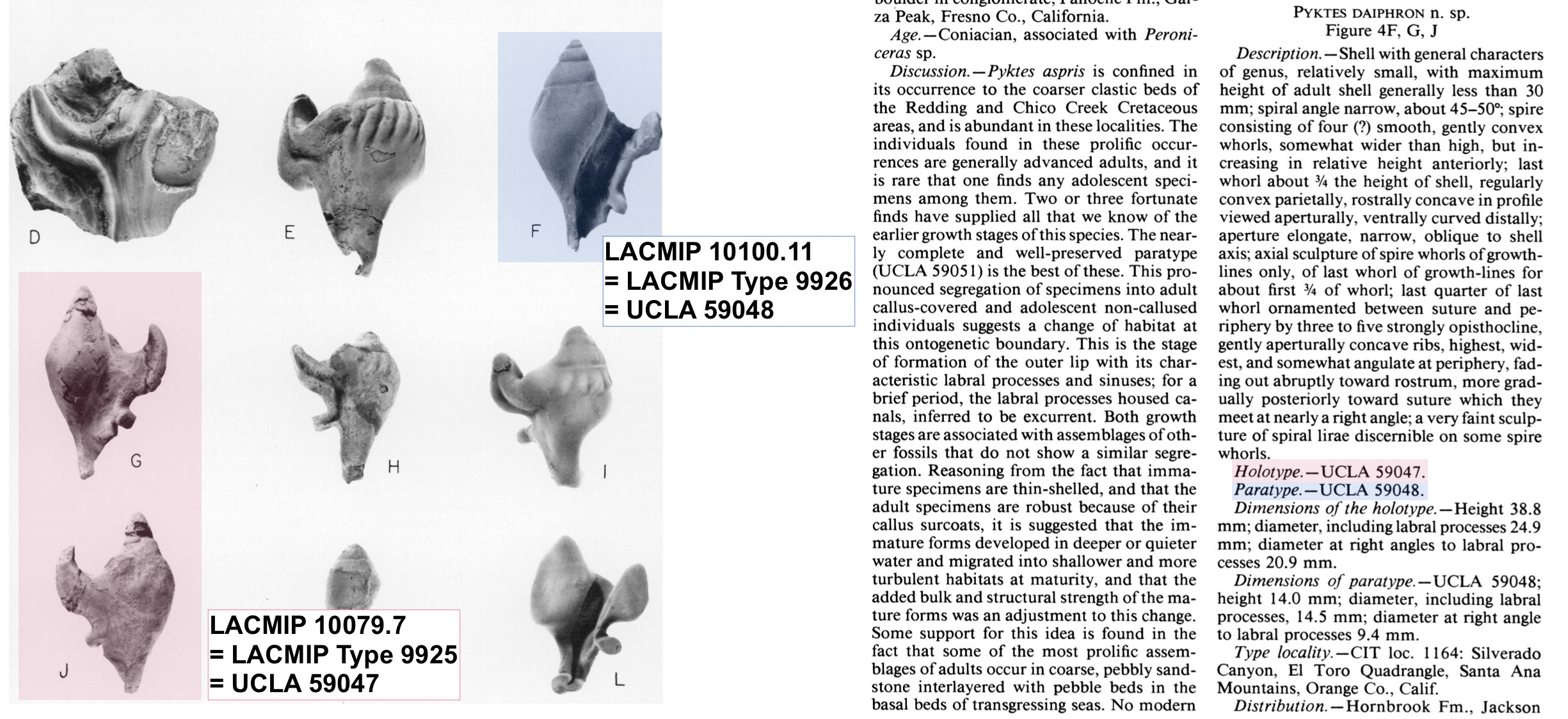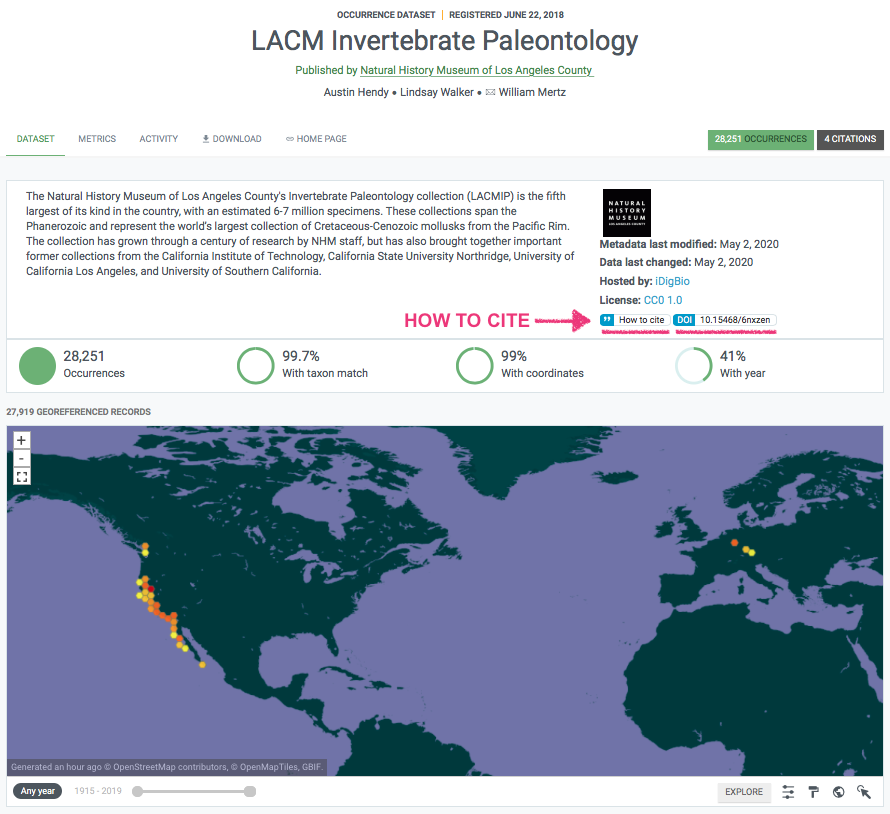Citations
Proper citation of museum collections is critical to sustaining these resources and the reproducibility of your research. If you intend to include LACMIP specimens or localities in a forthcoming work, please follow the guidelines below. In exchange for the use of LACMIP collections data in your research, we request that any resulting publications be shared with LACMIP staff.
![]() Our printable checklist for authors is available here.
Our printable checklist for authors is available here.
![]() Are you donating specimens in need of LACMIP numbers for publication? This process is outlined here.
Are you donating specimens in need of LACMIP numbers for publication? This process is outlined here.
Citing LACMIP specimens
How to cite?
Type specimens should be referenced in-text using the catalog number and the type number.
Example: “LACMIP 2533.234, LACMIP Type 3364”
Specimens that are not name-bearing types only require citation of the catalog number. This includes new figured and unfigured hypotypes, as well as “mentioned” and “referenced” specimens.
Example: “LACMIP 42800.22”
Catalog vs. Type Numbers
All LACMIP specimens receive catalog numbers during digitization. Each catalog number includes a locality number and lot number (i.e., LACMIP loc#.lot#), and each lot may contain one or more individual specimens. If you intend to figure/illustrate a specimen from a lot with multiple individuals, it is LACMIP’s preference that a new catalog number be generated for each individual specimen.
Specimens that may also receive new type numbers include:
- holotypes, syntypes, paratypes, lectotypes, neotypes, allotypes
- figured specimens that are used in a formal taxonomic treatment
Specimens that do not receive type numbers include:
- unfigured specimens/hypotypes, mentioned/referred specimens
- figured specimens not used in a formal taxonomic treatment
If a specimen has a preexisting type number (even hypotypes), it must be referenced in-text alongside the catalog number. Please contact the collections manager if you are unsure what to do.
For specimens that have been digitized since 2015, catalog and type numbers can be found by querying the LACMIP datasets on GBIF and iDigBio, which currently include records for Cretaceous through Cenozoic marine invertebrates from California, as well as all insects from the Statz, Pierce, and Rancho La Brea insect type collections. These datasets will be maintained and expanded upon in the future:
For specimens that are not yet digitized and online, new catalog and or type numbers may need to be created. Please contact the collections manager to verify whether this is necessary.

What if I have numerous specimens to cite?
If citing both the catalog and type numbers in-text becomes overly cumbersome, the catalog number takes precedent in-text. However, both numbers should still be included elsewhere in the publication. We suggest doing so in either list or table format.
| Catalog No. | Type No. | Taxon |
|---|---|---|
| LACMIP 2533.234 | LACMIP Type 3364 | Bibio comosella Statz, 1943 |
| LACMIP 2533.235 | LACMIP Type 3365 | Bibio comosella Statz, 1943 |
| LACMIP 2533.236 | LACMIP Type 3366 | Bibio compta Statz, 1943 |
Brief history of these numbers
Comprehensive inventories of the LACMIP type collection were first published by Wilson and Bing (1970) and Sphon (1973). Supplements to these catalogs, including specimens transferred to LACMIP from UCLA, were later published by Wilson (1986), Saul (1991), and Saul (1993). In subsequent decades, catalog numbers were assigned to all specimen lots, which now serve as the primary identifiers for LACMIP specimens. Now that LACMIP’s collections are becoming available online, citing the relevant numbers is necessary to enable full digital connectivity between these specimens and the published literature.

Citing LACMIP localities
LACMIP localities should be cited in text as “LACMIP locality #” or “LACMIP loc. #”. This format eliminates potential confusion between LACMIP locality and type numbers.
Example: “LACMIP loc. 2533” or “LACMIP locality 2533”.
Each LACMIP locality number is intended to represent a unique collecting/sampling event at the finest geographic and stratigraphic resolution possible. Consequently, if a field party collects fossils from the same location over two days, two locality numbers will apply, even if the collecting events share the same coordinates.
If you would like to request new LACMIP locality numbers, download and complete the LACMIP Locality Request Form and submit it to the collections manager, along with any relevant documentation, including collecting permits. (Open form > File > Download).
Citing the collections as an entity
The LACMIP collections can also be cited as a whole by including the suggested citation for our GBIF dataset in your reference list. Please do so if your research has benefitted from our collections in any way:
Example: Hendy A, Walker L, Mertz W (2020). LACM Invertebrate Paleontology. Version 1.8. Natural History Museum of Los Angeles County. Occurrence dataset https://doi.org/10.15468/6nxzen accessed via GBIF.org on 2020-07-21.

A customized and citable data download may be generated to reference digitized LACMIP specimens in publications. Contact the collections manager if you would like assistance creating one.

Contact information
Please direct questions and related inquiries to the collections manager.